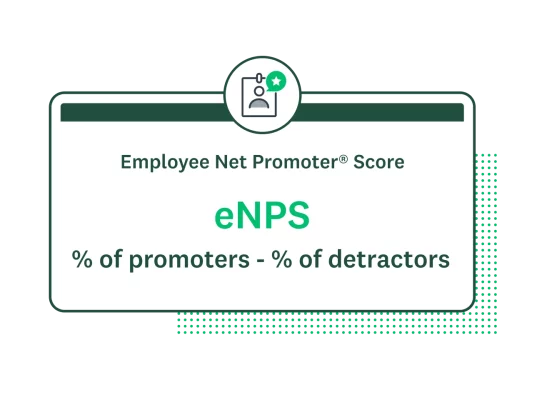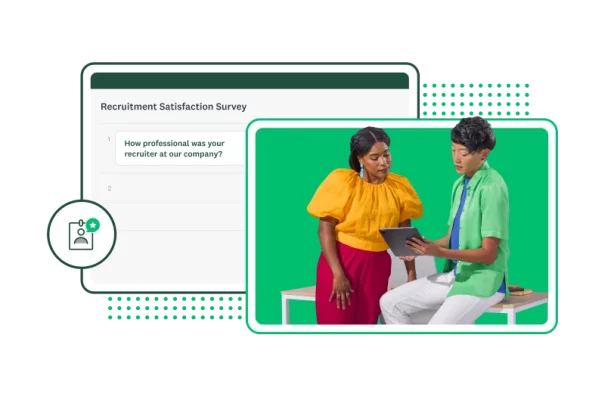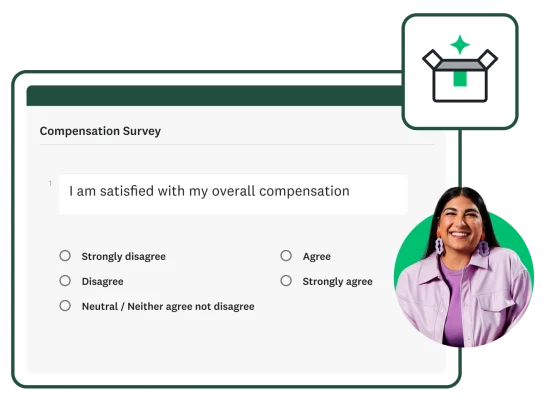The ultimate guide to collecting employee feedback
Your employees have the answers that’ll help you grow. Here’s how to listen.

You want motivated, high-performing, loyal employees. Building this type of workforce takes time, but it’s not as ambitious as you might think. Finding the right people starts with regularly asking for employee feedback. The answers you get will help you make meaningful changes to your workplace culture, employee satisfaction, and employer brand.
In this guide, you’ll learn how to build an effective employee feedback strategy, whether you’re responsible for 10 or 10,000 employees. Keep reading for insights into today’s workforce, lots of employee feedback examples, and tools and resources to get started today.
CHAPTER 1: THE IMPORTANCE OF EMPLOYEE FEEDBACK
What is employee feedback?
Employee feedback is the opinions, comments, and information employees give about their job, coworkers, workplace, and overall employee experience. Businesses, organizations, or HR teams collect and act on employee feedback to:
- Improve job performance
- Increase employee satisfaction
- Foster an inclusive, diverse workforce
- Encourage employee development and growth
- Offer competitive compensation and benefits
- Streamline processes and workflows
- Enhance communication across the company
Because there are various dimensions to the employee experience, many organizations implement an employee feedback program. This is a more formal process where HR teams and other stakeholders create a plan for collecting and acting on employee feedback. Effective employee feedback management involves setting goals, measuring progress, and making timely improvements.
Why is employee feedback important?
Our April 2024 Workforce Survey showed that over one-third of workers have seriously considered quitting their jobs in the last three months. “Quiet quitters” who, according to Gallup, make up about 50% of the U.S. workforce. Here’s what else recent feedback has revealed about today’s employees:
- According to our survey of HR professionals, the top reasons for employee turnover are compensation and benefits (35%), lack of flexible work arrangements (29%), and poor work-life balance (27%).
- We surveyed women in the workforce: work-life balance has worsened over the last year (20%), but their ability to work remotely is a main reason for staying at their job (54%).
- Backfilling an employee–especially a highly trained one–isn’t cheap. It’s tough to put an exact number on how much it costs to replace an employee. Some estimate that it costs up to 150% of a role’s salary.
- According to Gallup’s 2023 State of the Global Workplace Report, 41% of employees would change engagement or culture to make their organization a great place to work.
- Employee morale matters. We found that 94% of employees who feel their work is meaningful haven’t experienced work burnout within the last six months, while 75% of those who don’t feel their work is meaningful have.
Maybe some of these insights have already got you thinking about improvements you can make to your own organization. However, your employees likely have unique experiences and perspectives. By collecting employee feedback, you can tailor organizational improvements that greatly impact employee retention.
Improve company culture and your employer brand
Use employee feedback to inform your employee value proposition (EVP) in a competitive job market. By connecting your employees with your company values, you can foster a healthy work culture. A strong EVP and happy employees will improve employer branding, making it easier to attract high-quality candidates.
Keep employees engaged and invested
It might seem like common sense: employees who are more engaged and invested in their work will do better overall. That’s more than enough reason to make employees feel empowered and like they can contribute to company goals. But if you need more convincing, Gallup’s same 2023 report estimates that low engagement costs the global economy $8.8 trillion dollars.
Improve the customer experience
The more engaged your employees are, the better your customer experience. Highly engaged employees are more likely to spend extra time solving customer problems or pain points, whether through service or product improvements. Employees who truly care about their jobs will also be more likely to communicate customer feedback and issues to teammates or coworkers who can address them.

Benefits of an employee feedback management program
Collecting employee feedback is a great first step towards attracting and retaining employees. Next, you should establish some processes around employee feedback management, which will help streamline every part of the employee experience.
Recruit and hire top candidates
Employee engagement and satisfaction start before your employees do. Regularly collect feedback from job applicants and interview candidates to ensure everyone is treated fairly. When you measure and track the candidate experience, you better understand your employer brand reputation and what you need to do to attract top talent.
Onboard new employees more effectively
Collect employee feedback from new hires to streamline your onboarding and employee training. Ask employees about the effectiveness of your training materials. See how engaging your onboarding is. Find out if employees feel supported throughout the process. And use interactive online quizzes to drive home company values, protocols, and policies. Even the scores you get give you insight into how well your onboarding is going.
Improve employee performance and growth
Implement an employee performance management system to create a culture of feedback and transparency. Ask managers and employees to conduct self-reviews, too, so you can identify opportunities to help them grow or advance in their careers. You can also track team performance to see which teams need additional support or processes put into place.
CHAPTER 2: CHAMPION AN EMPLOYEE FEEDBACK PROGRAM
Identify stakeholders
You know collecting employee feedback is important. But if you want to truly make an impact, it’s a good idea to work with other people and teams who can help collect feedback, analysis, and action. Before you get too far in your planning, consider who you need to align with, starting at the top. Here are some of the stakeholders you should consider and the role they’ll play in your employee feedback program.
Executive leadership or C-suite
- Show they value a transparent, feedback-based work culture.
- Set company-wide review or feedback cycles where employees can prioritize giving thoughtful feedback.
- Acknowledge and directly respond to employee feedback data points, boosting morale and engagement.
Team managers or supervisors
- Receive valuable feedback that can help them improve their management.
- Deliver performance reviews to their direct reports.
- Encourage reports to engage fully with employee feedback cycles and surveys. Listen attentively during one-on-one meetings and escalate important feedback.
- Use feedback to help employees grow, connect them with training and growth opportunities, communicate with HR about work/life balance, and help implement policies to prevent burnout.
HR executives and managers
- Choose employee feedback tools and methods to collect and deliver feedback and performance reviews.
- Ensure that feedback collection is done anonymously and without bias.
- Track employee engagement and loyalty. Work with leadership to reduce the chances of burnout, encouraging leadership to make meaningful changes to workplace culture.
- Track and manage diversity, equity, and inclusion (DEI) efforts. Help ensure employees access equal opportunities and feel included and secure in their jobs.
- Use employee feedback to improve employee retention, attract candidates, and create or amend their employee values or branding.
Obtaining buy-in from executive leadership
More than one in five (22%) HR pros say a top challenge for collecting employee feedback is needing more leadership support. Leadership sets business priorities and often sets the tone for workplace culture. If they don’t think employee feedback is vital to recruiting and retention, you won’t get far in your efforts. Here are a few ways to build a convincing case for a company-wide employee feedback program.
Illustrate the ROI of employee feedback
Although a happy, productive workforce should be compelling in and of itself, you need to connect employee engagement and the customer experience directly. Present a business case that outlines the potential return on investment (ROI) of implementing an employee feedback program. Here are a few points to consider.
- Many studies have shown that dissatisfied employees are less likely to provide good customer service. According to our research, more than half (57%) of consumers say they’d stop doing business with a company after a poor customer service experience.
- Reiterate the important tie between employee engagement and productivity. A recent Gallup Poll shows that highly engaged employees are 17% more productive and have a 41% lower absenteeism rate.
- Customer KPIs aside, you can highlight the money your company would save by retaining employees rather than hiring and training new ones. Or the money you might save on recruiting by bolstering your employer brand. When you create a desirable workplace culture, you won’t have to try as hard to get people to work for you.

Align the program with organization-wide goals
Your organization likely has customer or employee retention goals, among many others. Find out what these are, then explain how your employee feedback program can help you achieve these goals. We’ll take you through how to do that in the next chapter.
Showcase feedback success stories
To drive the point home, share case studies and examples of how other companies have benefitted from similar feedback programs. For example, we use employee feedback at SurveyMonkey to drive meaningful changes to our workplace culture, diversity initiatives, and more.
We refined our manager training using employee feedback. We asked leaders across the company what we could do to help them be more effective in their roles. The feedback we received helped us prioritize two new trainings for our employees: a Management 101 course for new leaders and a more advanced curriculum for our more seasoned managers on how they can create high-performing teams.
There are many stories like this out there. Talk to people in your network or search for case studies that can help you prove your point. These stories will inspire your leadership to invest in a feedback program, too.
Launch a feedback pilot program
Before you invest a lot of time and resources into a full-blown employee feedback program, consider a pilot program. Starting on a smaller scale can help you gather initial data and test tools and pinpoint any issues with collecting employee feedback.
Your pilot program could be as simple as:
- Choosing a survey platform allows you to create, send, and analyze surveys easily. Because you’ll have multiple stakeholders, use a platform that allows for collaboration, like SurveyMonkey.
- Send a short survey to employees asking how likely they are to recommend your company as a great workplace. Ask them to explain their answers.
- Use this as an opportunity to connect with employees. For example, in your messaging, explain that the organization values their feedback and wants them to help shape the company’s workplace culture, values, and priorities.
- Analyze your survey and take action on the results (learn more in Chapter 6).
- Close the loop with both leadership and employees by sharing what you learned and your recommendations for improvement (learn more in Chapter 7).
- After making changes, survey again in a couple of months to see if and how employee feedback has changed.
At each step of this process, observe what’s working well and what's not and make adjustments. By starting small, you can relieve pressure and create the blueprint for a more extensive program that’ll stand the test of time.

CHAPTER 3: DEFINE GOALS, OBJECTIVES, AND KPIS
Define employee feedback program objectives
Collecting employee feedback in and of itself can have a positive impact on your workforce. It shows employees you care about their experience and are willing to improve. That said, you should set goals and meet specific objectives to make sure your program is having an impact. Here are some examples of goals, objectives, and key performance indicators (KPIs) you can use to measure your success.
Examples of goals, objectives, and KPIs
Goal: Increase employee loyalty
- Objective: Increase your employee Net Promoter Score (eNPS) by 20% within six months
- KPI: eNPS score (learn how to calculate)

Goal: Reduce employee turnover or churn
- Objective: Reduce turnover rate by 15% year over year (YoY)
- KPI: Turnover rate (learn how to calculate)
Goal: Improve training program effectiveness and relevance
- Objective: Increase overall satisfaction with training programs by 30% YoY
- KPI: Improve overall training satisfaction percentage
Goal: Enhance the recruitment process
- Objectives: Increase candidate satisfaction. Reduce the amount of time it takes to fill open roles.
- KPIs: Improve overall candidate satisfaction score percentage. Reduce time to fill (learn how to calculate).
CHAPTER 4: COLLECT EMPLOYEE FEEDBACK
Types of employee feedback
You can collect feedback on any part of the employee experience, including:
- Employee satisfaction. Learn how employees feel about their workload, work-life balance, and job security.
- Growth opportunities. Identify training and development opportunities for skill development and career growth.
- Compensation and benefits. Get feedback regarding compensation packages, benefits, vacation time, and more.
- Management, team structure, and communication. Assess manager performance and how well teams work together.
- Recruiting and hiring. Ask job seekers for their opinions to understand your employer reputation. Also, make sure your hiring process is respectful and fair.
- Diversity and inclusion. Measure how well you’re fostering and supporting a diverse workforce.
- Performance management. Ask employees to conduct manager, peer, and self-evaluations with an employee evaluation form or survey.
- Workplace protocols and processes. Gain insights aimed at enhancing workflows and driving scale.
Determine feedback channels
For a holistic picture of the employee experience, you can collect employee feedback in different channels and data formats:
Surveys
- Surveys are versatile because you can send them to employees in many ways. Automatically send email surveys and reminders. Post a survey web link on Slack or another internal messaging channel. Use a survey in offline mode to collect feedback anywhere, like at a recruiting event.
- You can embed a survey or form into your website if you need to collect applicant feedback or information. Learn about all the different ways you can collect survey responses.
- Collect both quantitative and qualitative data at scale. The quantitative data (numbers, percentages) are great for setting benchmarks and tracking progress. Qualitative data, or written responses, can help you gain more context for your data.
- You can use surveys to collect anonymous feedback on many topics, including sensitive ones. This might make employees feel more comfortable providing candid feedback.
Review websites
- Pay close attention to reviews you get on job sites like Glassdoor and Indeed. Former and current employees might have much to say about your leadership, policies, work culture, etc.
- Monitor social media like X (formerly known as Twitter) and LinkedIn to see what candidates and employees say about your company.
- Get to know any industry-specific sites or feedback channels that are popular with your workforce. Most importantly, don’t get defensive in the face of negative feedback. Listen first, then decide what you can ignore and what you can use to improve.
Interviews and one-on-one meetings
- When hiring or interviewing, note any feedback a candidate might have about your hiring process or organization.
- Managers should ask for feedback from their reports during one-on-one meetings. According to the experts at Bonusly, ask questions like “What aspects of your job have energized you recently?” and “What support do you need from me this week?”
- Similarly, direct reports can ask managers for feedback in their one-on-ones. Some examples are, “Is there anything I should be doing differently?” and “What are your long-term goals for the team?”
Performance reviews
- Assess employee impact and areas for improvement with annual or semi-annual performance reviews. Many organizations prefer surveys, making collecting self, peer, and manager evaluations easy. Some examples are the 360-degree employee evaluation survey, the manager feedback survey, and the employee performance survey.
- Employees can make the most out of their performance review meetings with managers by asking for feedback that can help them improve. Indeed recommends asking questions like, “What would make me a candidate for a promotion?” and “Are there any opportunities for professional development?”
- Managers can also ask leadership for feedback. Some examples include, “What is our company’s greatest challenge right now?” and “What could I focus more time on?”
Gather feedback throughout the employee lifecycle
The employee lifecycle includes every interaction an employee has with your organization, including the experiences of potential and former employees.
Collect feedback at each stage of the employee lifecycle, from recruiting to offboarding. The insights you gather will help you change your workplace and culture to attract and retain high performers.

Recruiting
Get to know what candidates think about you as a potential employer. Their feedback can help you strengthen your employer brand, better understand your candidate pool, and enhance the recruiting experience.
You can collect feedback by sending potential employees a candidate experience survey. Send this survey to anyone who interviews with your company, including those who don’t end up working for you. This will help you understand if interviewees feel they're being treated well throughout the interview process. Here are a few examples of the questions you can ask candidates:
- Overall, how satisfied were you with the entire recruiting experience at our organization?
- Do you feel like you met with a diverse panel of interviewers?
- How clearly did your recruiter describe the interview process?

Onboarding
Once you hire an employee, the next step is to onboard them. Make sure you’re getting them up to speed as quickly as possible and that they’re retaining crucial information about your policies, organization, and job duties. Here’s how employee feedback can strengthen your onboarding:
Streamline your onboarding process. The more quickly you onboard employees, the more quickly they become productive. Use a new hire onboarding survey to understand which parts of the onboarding process could improve. Ask questions like:
- How clear did you find the information presented during the onboarding?
- Should onboarding have been longer, shorter, or was it just about right?
- Any further comments regarding the onboarding process?
Improve your training materials. Whether your onboarding and training is in-person or remote, determine if your presentations and activities are engaging and informative. Send attendees a new hire training quiz to see how well employees retained and understood your onboarding information. Ask questions like:
- How many customers use our product every year?
- About how many employees work at our company worldwide?
- Which of these are our company’s values? Select all that apply.
Set up your new hires for success. Onboarding doesn’t end after the first couple of weeks. Ask for employee feedback at regular intervals.
Send a 30-day onboarding survey to understand the effectiveness of your initial employee onboarding. Ask questions like:
- How satisfied are you with your new role so far?
- Have you finalized your 30-60-90-day plan with your manager?
- Have you had meet-and-greets with your new colleagues?
Next, send a 60-day onboarding survey to check in with your new employee. This will help them feel supported while you’re also checking in on the continued effectiveness of your onboarding. Ask questions like:
- How are you feeling about the onboarding process so far?
- Have you achieved your 60-day goals?
- Do you feel you are getting too much, not enough, or the right amount of feedback from your manager?
Finally, send a 90-day onboarding survey to get final employee feedback on their overall onboarding experience. This survey will help you understand how well a new hire has settled into their role, if they feel empowered, and start a conversation around growth opportunities. Ask questions like:
- Are you now working on your job tasks fully independently, mostly independently, or with frequent support?
- How helpful has the 30-60-90 day onboarding plan been in adjusting to your new role?
- What could have been done differently to improve your onboarding experience?
Development
Are you providing growth opportunities for your employees? The HR professionals we surveyed said that career advancement opportunities are the second most important factor when candidates consider a new job (44%). Here are a few ways to use employee feedback to ensure you’re offering enough growth opportunities.
Offer a robust learning and development program. Professional growth is important to employees and offering relevant activities and content. Use a professional development survey to ask questions like:
- What type of professional development activities would you find the most helpful? (Select all that apply.)
- How supported do you feel in your workplace to be able to pursue professional development?
- What is the main reason you would want to spend time on professional development?
Make sure employees are satisfied with their career growth. Similarly, you want to be sure your employees feel they can advance in their careers. You can also send them a career development survey, which asks employees to rate their satisfaction:
- I am satisfied that I have the opportunity to apply my talents and expertise.
- My organization is dedicated to my professional development.
- I am satisfied with the job-related training my organization offers.
Prioritize self-evaluation and growth conversations. You can also use surveys to formalize regular conversations around career growth and job performance. For example, this employee review survey is a self-evaluation focused on growth, impact, and goals. When you send this survey to employees, they use feedback to drive an essential conversation with their managers. Questions in this survey include:
- What was my impact last quarter?
- What could I have done differently to have a greater impact?
- What will I do this quarter to have an impact?

Retention
You’ve invested a lot into recruiting, onboarding, and developing a solid workforce. Now you’ve got to make sure they won’t leave you for another opportunity. At this stage, check in with employees to see if they’re engaged, fulfilled, and happy with how things are going.
Boost employee engagement. How motivated and invested are your employees? Use a work engagement survey to measure employee morale. Send this survey regularly so you can make targeted improvements to the employee experience and track engagement over time. In this survey, employees respond to statements like:
- I am determined to give my best effort at work each day.
- I am inspired to meet my goals at work.
- I get excited about going to work.
Avoid employee burnout. In recent years, burnout has become a real issue for many employees. Check-in with your employees to see how they’re feeling. Then, see what you can do to alleviate some of their stress. Send a work-life balance survey that asks:
- How often do you work overtime or outside regular work hours?
- How satisfied are you with your current work-life balance?
- In your opinion, what improvements can be made to your work-life balance? Please comment below.
Foster an inclusive work culture. The best way to attract diverse and talented people is to build a workplace culture that prioritizes belonging and inclusion. But having a diverse workforce isn’t enough. One study found that 60% of workers have witnessed or potentially witnessed microaggressions in the workplace.
Your company must check in with employees regularly to ensure they feel supported. When you send employees a belonging and inclusion survey, you’re taking the first step toward identifying and addressing inequities at work. Ask questions like:
- I can voice a contrary opinion without fear of negative consequences.
- Administrative tasks that don’t have a specific owner (e.g., taking notes in meetings, scheduling events, cleaning up shared space) are divided fairly at my company.
- Promotion decisions are fair at my company.
Offer competitive benefits and compensation. Compensation packages are a big factor in retaining talent in a highly competitive job market. In a recent SurveyMonkey study, 54% of HR pros ranked compensation and benefits as an area where companies must invest in their employees. Use a compensation and benefits survey for answers to questions like:
- I am compensated fairly relative to my local market.
- I am satisfied with the retirement plan offered by my organization.
- I am satisfied with the amount of paid leave offered by my organization.

Offboarding
The end of an employee’s time with your company can be as important as the beginning. When an employee leaves your company, finding out why is essential. Exit surveys help you build a more attractive and fruitful culture so current and future employees will stay longer and feel more engaged. Use an exit interview survey that asks questions like:
- How effectively did you feel your skills were put to use here?
- How helpful was your position here in stimulating your professional growth?
- What actions can the company take to build a better workplace?
CHAPTER 5: THE BEST EMPLOYEE FEEDBACK SURVEYS
Using eNPS to measure employee loyalty
How likely are employees to recommend your organization as a great workplace? The answer has become the industry standard for measuring employee loyalty. Getting your eNPS, or employee Net Promoter Score, is a quick way to understand employee engagement and their investment in your organization. Here are some tips and best practices for collecting employee feedback with an eNPS survey.
- The eNPS question is versatile. You can send it as a stand-alone survey. Or you can include the eNPS question in just about any type of survey, from a regular employee engagement survey to an exit interview.
- Customize your eNPS and get the “why” behind your score by asking additional qualifying questions in your eNPS survey. One example is “What is the primary reason for your score?”
- Because eNPS is an industry-standard, you can benchmark it against similar organizations in your industry. If your eNPS is better than others in your industry, you’re probably doing a great job keeping employees happy and engaged. You can also benchmark your eNPS against yourself, tracking dips and peaks, making sure that your number holds steady or mostly trends upwards.

DEI surveys
According to our research, almost half (48%) of HR pros say that DEI has greatly impacted hiring top candidates. This is even higher at companies where HR leads (55%). To gauge the inclusiveness of your workplace culture, send DEI surveys to your employees. The employee feedback you get will help you understand what you’re doing well and where there’s room for growth.
- Gender inclusivity at work survey: Better understand the needs of nonbinary and transgender workers and measure everyone’s understanding of gender-neutral practices. Ask questions like, “How difficult would it be to use gender-neutral pronouns to refer to someone who asked you to?”
- Organizational culture survey: This survey helps you understand your workplace culture holistically. You can customize this survey to focus on DEI to ensure everyone feels welcome and supported. Ask questions like “How dedicated is your organization to diversity and inclusiveness?” and “According to you, how does this organization define ‘success’?”
- Culture pulse survey: Use this survey to capture employee feedback about your company culture quickly. This is especially helpful if you want to understand whether the work environment is diverse and inclusive. Ask employees to respond to statements like “My organization has a safe work environment” and “My organization operates in a socially responsible manner.”
Employee engagement surveys
When employees are engaged with their work, they’re more fulfilled and more motivated. An engaged employee who feels aligned with your organization’s goals not only performs better, they help attract top talent, and stays longer. Use these surveys to measure different dimensions of employee engagement:
- Employee engagement survey template. Learn if employees are happy with their benefits, satisfied with their jobs, and feel aligned with your organization’s goals. Ask employees to respond to statements like “I am inspired to meet my goals at work” and “I am determined to give my best effort every day.”
- Employee motivation survey template. This survey focuses on how driven employees are to do their best work. It’s a short survey that you can use to assess motivation and track it over time quickly. Ask employees to respond to statements like “When at work, I am completely focused on my job duties” and “I am often so involved in my work that the day goes by very quickly.”
- Employee satisfaction survey template. Get to know how well your organization is meeting or exceeding employee expectations. This employee satisfaction survey is beneficial if you’re having trouble retaining employees. Ask questions like “How realistic are the expectations of your supervisor?” and “How likely are you to look for another job outside the company?”

Employee benefits surveys
Benefits or perks may have gotten even more important in recent years. According to a Forbes report, 40% of employers think workers leave their jobs to find employment that offers better benefits. And one in 10 workers say they’d rather take a pay cut to access better benefits. How satisfied are employees with the benefits your company offers? Use these survey templates to find out.
- Workplace benefits survey template. See if employees are satisfied with the benefits you offer and what could be better. Ask employees to respond to statements like “I am satisfied with the workplace flexibility offered by my organization” and “I am satisfied with the healthcare-related benefits offered by my organization.”
- Work-life balance survey template. When you send this survey to your entire organization, you can get a general understanding of employee sentiment. Another great way to use this survey is to slice and dice the data to see if different teams feel differently about their work-life balance. Ask employees to respond to statements like “My work schedule allows me to spend time with my family and friends” and “I have enough time when I get home to decompress from my workday.”
- Compensation and benefits survey template. According to Gallup’s 2023 State of the Global Workforce report, 28% of respondents who considered quiet quitting said they wanted changes to pay and benefits. Find out how well you’re meeting employee expectations. Ask employees to respond to statements like “I am satisfied with my overall compensation.”

Pulse surveys
Sometimes, you need to send employees longer surveys, especially if your organization only holds formal reviews or assessments once or twice a year. However, more and more companies are using pulse surveys to quickly capture employee feedback and track sentiment outside regular feedback cycles.
- Employee pulse survey template. Just like you can measure your pulse any time, you can send these surveys when you need to check employee sentiment quickly. At the same time, regularly using pulse surveys to check in can give you a good understanding of your company’s overall health. Ask questions like “How confident are you in the direction this company is headed?” and “If you could change one thing about your job, what would it be?”
- Culture pulse survey template. Quickly identify areas where your company needs to improve your workplace culture. Ask employees to respond to statements like “My organization has a safe work environment” and “I am satisfied with my overall job security.”
Best practices for launching employee surveys
When you send a survey, you’re asking employees to take time away from their daily work to provide thoughtful feedback. Here are some best practices to make people more likely to take your surveys and give you accurate responses.
Enable anonymous feedback
Many of these employee feedback surveys touch on sensitive topics. Employees and job candidates might hesitate to give candid feedback if they fear it will impact their careers or hiring.
To make employees feel more comfortable, let them know that their responses will be anonymous and only be used in aggregate. You can send anonymous employee surveys by enabling anonymous responses in your survey settings.
Be clear and concise
- Spell out acronyms and avoid jargon. Even though you’re surveying in a work context, employees might not know HR-related acronyms and jargon.
- Keep your surveys as short as possible. Our research shows that shorter surveys have higher completion rates. We recommend keeping employee feedback surveys under 20 questions. One way to do this is by limiting the number of topics in each survey.
- Don’t use too many open-ended text response questions. Employees might not want to spend the time and effort filling these out, skipping questions instead. And the answers you get can be challenging to analyze.
Avoid biased or misleading language
- If you’re asking for demographic information or sensitive survey questions, ensure your language is inclusive and considerate.
- Be careful with phrasing and word choice. Asking leading and loaded questions can give accurate results and make employees feel heard.
- Ask the right questions every time with our expert-written survey templates. Our survey scientists wrote these customizable templates to get you reliable results. You can also easily drag and drop pre-written questions from our Question Bank into your survey.
- Consider using SurveyMonkey Genius, powered by AI and machine learning, for methodologically sound survey questions that meet your unique goals. All you need to do is provide a good AI survey prompt, and SurveyMonkey will generate a complete survey that you can customize or use immediately.
Collect feedback regularly
Like fashion trends and baked goods, employee feedback will go stale. You'll want to collect feedback regularly to keep up with changing sentiments and proactively address employee engagement.
Many organizations conduct performance reviews at least once a year. These can be peer and manager feedback surveys, self-evaluation surveys, 360 reviews, and more. You can also send an employee engagement survey at the same time or ask questions about employee satisfaction in your performance review surveys.
Send pulse surveys outside of your regular employee feedback cycle. This will help you pinpoint any issues that come up between performance reviews. You can also do a quick pulse survey after a significant change or company-wide event to see how you’re doing.
CHAPTER 6: ANALYZE FEEDBACK AND TAKE ACTION
You’ve got your employee feedback. Now, it’s time to categorize what you’ve found into overarching themes. And get a better idea of where you stand before you decide how to move forward.
- If feedback speaks directly to your KPIs (for example, your eNPS score), benchmark those data points. In other words, document those results so you can report on your progress and show the ROI of your employee feedback program.
- You’ll also want to establish your benchmarks for employee engagement. Note your initial survey results. Repeat the same survey and compare how sentiment goes up, down, or stays relatively the same over time.
- If you use SurveyMonkey templates and pre-written questions from Question Bank, you can benchmark your results against similar organizations in your industry.
- Read up on employee and workplace trends for more context on how your organization is performing. For example, our recurring CNBC|SurveyMonkey workforce survey report can help you track and understand workplace and employee trends throughout the year.
Analyze data for key insights
Part of understanding higher-level themes is drilling down into your data. What you learn will help you speak to those themes and tell your story.
- To analyze your survey data, look at the raw numbers and percentages of your close-ended survey questions. Charts and graphs allow you to visualize data quickly, such as “How satisfied are you with your job?”
- Slice and dice your data to reveal hidden insights. For example, filter responses by different demographics and characteristics, like gender, ethnicity/race, years at the company, job role, and more. You can also compare responses to questions. For example, see how people who said they’re “extremely satisfied” with their job answered the question, “How likely are you to look for a new job in the next six months?”
- Take a moment to understand your survey response rate. (The number of completed surveys divided by the total number of survey invitations you sent.) For example, your most recent pulse survey had a 10% response rate. While most feedback is valuable, drawing sweeping conclusions from your collected data will take more work.
- Of course, if you’re asking employees to provide feedback in their own words, you should take the time to read their responses. But you can also turn open-ended feedback into actionable insights with our survey text analysis tools, like word cloud visualizations and sentiment analysis.

Develop an action plan
Once you’ve performed your analysis and found key insights, it’s time to turn those into action. Here are a few things to consider:
- What are your organization's top priorities? Look at your employee feedback program goals. If your goals involve employee loyalty and retention, focus on addressing feedback that impacts those numbers.
- Urgency versus importance. While employee benefits satisfaction might be necessary to your organization, you should focus on addressing urgent feedback first. For example, if employees indicate poor work-life balance and consider leaving the company in the next six months, focus on building a healthy work culture.
- Overall employee engagement and the impact on your customer experience. If your employees aren’t feeling empowered or engaged, focus on ways to make them feel more connected to customers. Demonstrate their value. Show that your employees have an essential role and that they directly impact the company’s success. Here are some ideas for boosting employee engagement.
CHAPTER 7: CLOSE THE FEEDBACK LOOP
Sharing feedback with employees
Part of your action plan should be reporting back to employees on what you learned and how you’re addressing their feedback. This shows employees that you value what they have to say. And you appreciate the time they spent giving you thoughtful feedback.
Steps for closing the loop
- Your action plan should specify the employee feedback you’re addressing, who’s responsible for making changes, and how they’re taking action. Even if these changes haven’t been made before you connect with employees, your next steps should be clear and timely.
- Choose how to tell employees about the changes you’re making. How you do it depends on your organization's size, workforce distribution, and workplace culture. Some options include sending an email, speaking about it at a company-wide meeting, or addressing the feedback in a small group.
- Make sure employees are generally satisfied with the changes. Send a follow-up survey to collect more feedback, iterating as needed.

How to give employee feedback
Establish a standard process for performance reviews or individual conversations that ensures people deliver feedback respectfully. You can equip managers with a framework that’ll help them hold performance reviews and conduct feedback sessions. Keep reading for some examples of employee feedback that’ll help you conduct fruitful conversations.
Employee feedback examples
- Positive employee feedback examples: When you give positive feedback, you tell employees what they’re doing well. Draw attention to excellent behaviors that you want to turn into habits. Give sincere thanks to employees who exceed expectations. This is a good opportunity to introduce incentives or an employee recognition program, which rewards employees for their efforts.
- Unfortunately, not all feedback is positive. For example, if employees feel their supervisor has unrealistic expectations for their workload, their supervisor should get that feedback. Although the input itself is negative, you can constructively deliver the feedback.
- For performance reviews, you’ll have a more standard process in place. For example, a manager might schedule a meeting with their employee. They’ll review their performance, give them positive and constructive feedback, notify them if they received a promotion, and provide enough time for the employee to address feedback and ask questions.
- There might be less process for ad hoc meetings where someone wants to deliver positive or negative feedback. However, managers and HR need to be aware of the conversation and the outcome or next steps for difficult conversations.
- If appropriate, you can benchmark a current KPI (like eNPS or employee turnover rate) and assign an objective the feedback recipient should try to meet by the following performance review or another significant period.
CHAPTER 8: DRIVE CONTINUAL IMPROVEMENT
Remember that collecting employee feedback isn’t a one-time process. You'll need to regularly gather feedback to boost employee engagement, growth, and your bottom line.
- Hold recurring self-assessments or evaluations where employees reflect on their impact and how they can continue to grow.
- Establish a consistent performance review cycle, though be willing to adjust when and how performance reviews happen based on employee feedback.
- Be ready to send pulse surveys after a big change, like an acquisition or layoff. This will help you proactively address issues before they negatively impact your overall employee engagement or workplace culture.
- Keep checking in on your original employee feedback program goals, making adjustments as your employee and organization priorities change.
- Plan to re-evaluate your employee feedback program regularly and as needed.
- Continue to close the feedback loop with stakeholders, employees, and management.
Ready to grow? Start listening to your employees
Be the employer that everyone wants to work for. Get started in minutes with one of our employee feedback survey templates. Or learn how SurveyMonkey can help you boost employee engagement.
Learn the difference between employee engagement and motivation, and discover concrete ways to encourage both within your workforce.
Employee productivity measures how your employees add to your business. Calculate and improve productivity rates.
Learn how to build your leadership development program to enhance employee engagement, build a culture of continuous learning, and drive success.
Enhance workforce management and engagement through our in-depth guide on the employee lifecycle.
Ready to get started?
Net Promoter Score and NPS are registered trademarks of Bain & Company, Inc., Fred Reichheld and Satmetrix Systems, Inc.
Discover more resources

HR toolkit: Make employee experience your competitive advantage
HR leaders can use this toolkit to help drive exceptional employee experiences.

State of Surveys: Top trends and best practices for 2025
Watch this webinar to explore 2025 survey trends, mobile insights, and best practices for optimizing your survey strategy.

How Americans feel about the Costco DEI policy: 25+ stats and 10 tips
68% of Americans back Costco’s DEI commitment. Explore 25+ stats on public sentiment around Costco, DEI policies, and the anti-DEI movement.

How to get more out of your employee engagement surveys
Learn how to design, analyze, and apply employee engagement surveys to drive meaningful change and improve workplace culture.